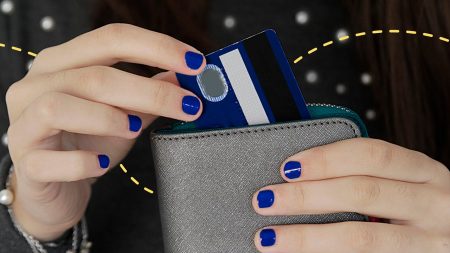When Courtney and Lindsey Norton got married 12 years ago, they began sharing more than a last name — they also shared six figures of debt.
They had an $80,000 mortgage, $80,000 in student loans, $10,000 in credit card debt, $3,000 in auto loans and even payday loans. “It was really, really bad,” Lindsey says.
In order to raise their three kids and begin repaying debt, the Nortons knew they needed additional income. Lindsey was a skilled baker, and the duo began selling homemade cookies out of their kitchen. The side hustle was a huge success. Five years later, they’ve paid off their debt and even opened a storefront for the cookie business — Nookies Cookie Co. — all while working their day jobs.
Rachel Seymour lives in a different part of the country and her circumstances differ from the Nortons, but she, too, faced a debt problem.
Seymour decided to wait tables and pick up freelance work to help pay off the credit card debt she’d accumulated while living in New York City. Sacrificing her free time helped her become debt free in less than a year.
Seymour and the Nortons are part of the 36 percent of Americans who have a side hustle, or extra money earned beyond one’s main source of income. And 1 in 5 (20 percent) of those Americans with side hustles use it to pay down debt, according to Bankrate’s 2024 Side Hustles Survey.
Key insights on using a side hustle to pay off debt
Key insights
- Some Americans with a side hustle use it to pay off debt. Other popular uses of side hustle income include discretionary purchases, regular living expenses and saving.
- Many Americans have credit card debt. In addition to working extra hours or taking on a side hustle, some people plan to use their tax refund to pay off debt. Others say they’ve cut expenses or applied for a balance transfer card, among other repayment strategies.
- You can use a side hustle to repay your credit card debt or other types of debt. You’ll just want to make sure the side hustle is legitimate and calculate a repayment plan.
How Americans are spending their side hustle income
According to new Bankrate data, more than 1 in 3 (36 percent) of U.S. adults have a side hustle. If you had a couple hundred extra dollars in your pocket, what would you spend it on?
Here’s how side hustlers are using their extra income:
- Discretionary spending: 37 percent of side hustlers
- Regular living expenses: 36 percent of side hustlers
- Savings: 31 percent of side hustlers
- Debt repayment: 20 percent of side hustlers
Credit card debt is on people’s minds
Even though debt repayment was the least popular use of extra funds among side hustlers, credit card debt is a reality for many Americans.
More than 2 in 5 (44 percent) American cardholders carry a credit card balance from month to month, according to Bankrate’s Chasing Rewards in Debt Survey. And according to Bankrate’s Credit Card Repayment Strategies Survey, 21 percent of Americans who’ve had credit card debt have worked extra hours or taken on a side hustle specifically to earn money for credit card debt payoff.
Here’s how these side hustlers paid off debt with extra income
I spoke with the Nortons and Seymour to learn how they successfully paid off credit card debt with their side hustles.
Selling homemade cookies
Both of the Nortons, who live in Cookeville, Tennessee, work full time. Lindsey, 40, is a procurement specialist, and Courtney, 41, is a warehouse supervisor.
Courtney and Lindsey started their marriage with six-figure debt. That’s why they decided to begin selling cookies out of their home.
Lindsey was already an active baker. When she was going to school and working full time, “[baking] became my stress relief,” she says. “I would spend hours on end in the kitchen at night.”
When Lindsey baked cookies as a hobby — like her company’s now-best-selling banana pudding cookies — she would give them to Courtney to bring to work. His coworkers appreciated the cookies, and they began dropping by Courtney’s desk offering to buy more.
In their town of Cookeville, the only cookie businesses were decorators who took several days to make orders. The Nortons saw an opportunity for a side hustle to help tackle their debt and save up for their three kids’ college tuition. Cookie orders began rolling in, and so did profits.
After a successful five years of selling cookies, Nookies Cookie Co. opened a storefront. Lindsey takes her laptop into the store to work and run the store at the same time. “She’s Superwoman,” Courtney says.
Nookies Cookie Co. earns up to $3,000 a month, which has allowed the Nortons to put between $10,000 and $25,000 toward debt each year. Today, the Norton family is debt-free.
Courtney and Lindsey Norton sold cookies as a side hustle.
They earned around $3,000 a month they put toward paying off debt.
Freelance marketing and serving at a restaurant
Rachel Seymour, 28, works full time in email marketing. She moved to New York City in 2023 with plans of having a fun summer — and ended up maxing out two credit cards, leading to $10,000 in debt.
“New York is so much more expensive than what I was used to,” Seymour says. “I was living paycheck to paycheck with just my 9 to 5.”
She knew she needed more income to start paying off her credit card debt, so she picked up a freelance marketing gig and a job as a restaurant server. Then she laid out a debt repayment plan.
Most of the hours in her day were occupied with her work and side hustles. Sometimes, she worked seven days a week.
“I had no life,” she says. “I didn’t do anything for months.”
Seymour earned $3,000 a month with her freelance gig and up to $800 a week at the restaurant. After paying rent and necessary expenses, she put around $2,000 toward her debt each month. By January 2024, she was debt free. Plus, her credit score had improved.
Seymour sees the wisdom in having a few different sources of income, but also wants to “work to live, not live to work.” By managing her spending and responsibly using credit cards in the future, Seymour hopes to never have credit card debt again.
Rachel Seymour freelanced her email marketing skills and worked as a server as side hustles.
She earned about $6,200 a month to pay off debt
How to use a side hustle to pay down your debt
If you’re considering how to pay off credit card debt by earning more income, a side hustle might be the way to go.
Start by listing out the resources available to you — like your time, skills and social connections. Then, you can find a gig that fits your schedule and expertise. Lindsey Norton put her baking talents to use. And Seymour turned her full-time expertise into additional gig work.
Don’t be afraid to ask your network for potential opportunities. For inspiration, check out these 10 best side hustles.
Here are a few tips for successfully using a side hustle to pay off debt.
Make sure your side hustle is legitimate
Before you start pocketing extra income, you’ll want to make sure your ducks are — legally — in a row. Research IRS rules for gig work, because you’ll likely need to start tracking income and expenses and paying quarterly estimated taxes. And don’t forget about these small business tax deductions.
Consider whether you need insurance for your side hustle. You’ll want to be covered for any accidents or property damage. You could also open a business banking account and a business credit card, which could allow you to earn rewards on your expenses.
There are also scams to watch out for. Be wary if someone tries to sell you a side hustle or asks you to put money down for a gig.
Keep in mind: If the side hustle seems like a get-rich-quick scheme or too good to be true, it probably is.
Estimate your additional monthly income
Once you start earning extra money, it’s good to have an idea of how much you’ll earn each month as you repay debt. A key part of your monthly budget is estimating your income.
Look at the first few months of side hustling to come up with a number for your estimated revenue. It may vary depending on the season or your availability. Then, subtract any business expenses from your estimated revenue.
For example, if you start driving with a ridesharing app, you’ll want to deduct additional gas expenses and app fees from your revenue. Or if you’re selling a product, like cookies, you’ll deduct ingredient costs. And don’t forget to deduct estimated taxes, too.
Money tip: After subtracting business expenses and taxes from your estimated revenue, the money left over is what’s available to you for debt repayment.
Make a repayment plan
Creating a debt repayment plan ahead of time will keep you on track as you start bringing in side hustle money. It will also help you avoid lifestyle inflation, which is when someone starts spending more money as they earn more money.
Your debt repayment plan should factor in your additional income when calculating monthly payments. You might also consider a balance transfer card, debt consolidation or another debt repayment strategy to help you on your journey.
If you need help choosing a repayment strategy, here’s how to get rid of credit card debt.
Bankrate’s take: Debt repayment takes time and consistency, but earning extra income with a side hustle can help speed up the process.
-
Bankrate commissioned YouGov Plc to conduct the surveys. All figures, unless otherwise stated, are from YouGov Plc.
Side Hustle Survey: Total sample size was 2,332 US adults, of whom 822 have side hustles. Fieldwork was undertaken between 10th – 12th June 2024.
Chasing Rewards in Debt Survey: Total sample size was 2,239 adults, of whom 1,740 were credit cardholders. Fieldwork was undertaken between 24th – 26th January 2024.
Credit Card Repayment Strategies Survey: Total sample size was 2239 adults. Fieldwork was undertaken between 24th – 26th January 2024.
Read the full article here










